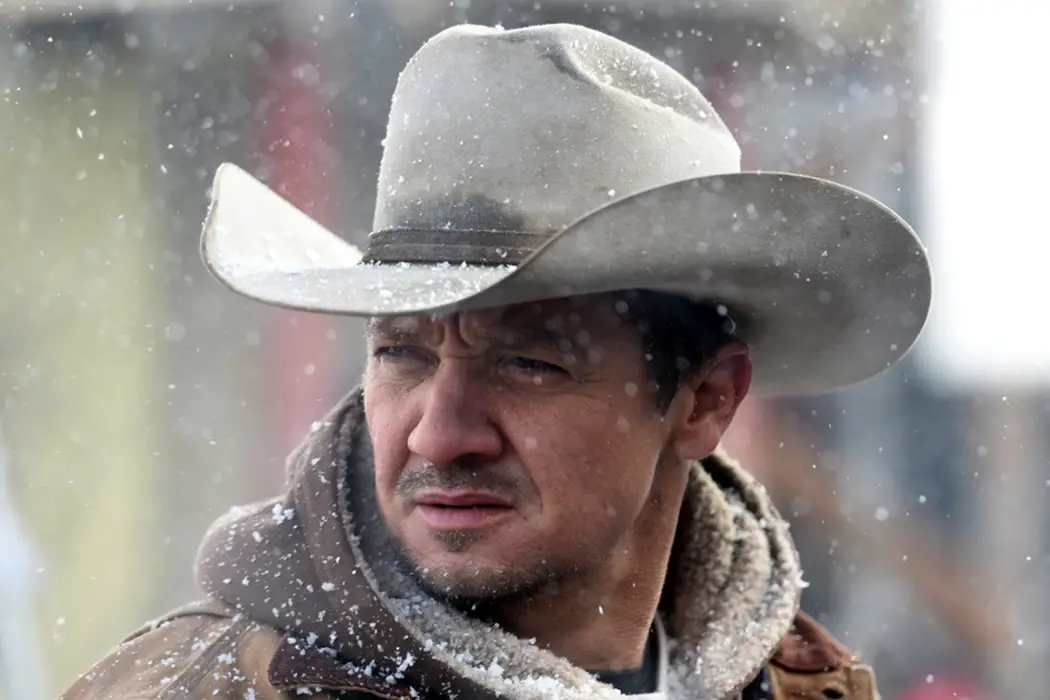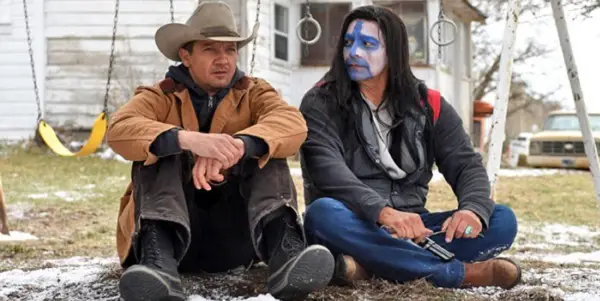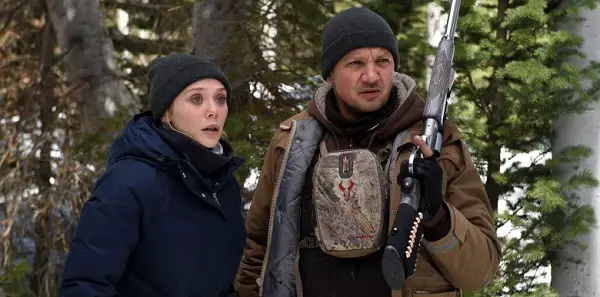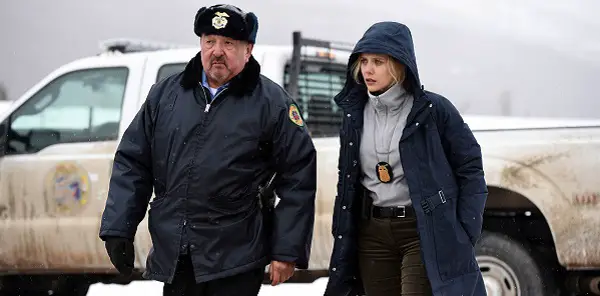WIND RIVER: The Year’s Most Haunting And Elegiac Thriller

Lee Jutton has directed short films starring a killer toaster,…
One of my favorite movies released in 2016, and one that unfortunately slipped under the radar of many moviegoers, is Hell or High Water. A Western-slash-heist drama with hot blood pulsing through its veins, it follows two brothers (a loose cannon, played by king of loose cannons Ben Foster, and a more level-headed mastermind, played by Chris Pine) as they carry out a series of minor bank robberies across the dried-out husk of the American West.
Their goal? To raise just enough money to buy back their deceased mother’s ranch, which is sitting on valuable oil deposits. In a part of the country where so many feel personally wronged by the faceless men in suits who run our financial institutions and make it seemingly impossible to get ahead, it’s no surprise that many of the witnesses to the brothers’ crimes refuse to give them up out of solidarity. It’s a tale of the American dream gone awry, one to which many of us can relate.
That film’s screenwriter, Taylor Sheridan, climbs into the director’s chair for Wind River, another script of his about people who have been victimized and then forgotten by the American government – this time, Native Americans. As the film tells us, the only demographic for missing persons not tracked by the FBI is Native American women; nobody knows how many are missing, and nobody seems willing to find out.
Wind River tells the story of one of those women and the two people who strive to bring her justice at all costs. And while the film’s message might have been even more potent if it had been brought to life by a Native American filmmaker, there’s no denying that it packs a hefty emotional punch. It’s a perfect companion piece to Hell or High Water, and cements Sheridan as one of contemporary cinema’s most timely storytellers.
Welcome To Wind River
U.S. Fish and Wildlife Service agent Cory Lambert (Jeremy Renner) is a skilled hunter and tracker. So, when livestock start turning up dead on the nearby Wind River Indian Reservation in Wyoming, he’s enlisted to track down and dispatch the culprit. As his estranged wife Wilma is Native American, and her family still lives on the reservation, Cory knows his way around the snow-covered plains and rocky hills of Wind River better than most. However, instead of finding the mountain lion believed to be responsible for the killings, he finds the barefoot corpse of an eighteen-year-old girl who lived on the reservation.
Her name is Natalie Hanson; she was best friends with Cory’s daughter, who was also found dead in the snow three years earlier. Needless to say, the discovery dredges up the tragic memories in Cory’s all-too-recent past. He vows on behalf of Natalie’s father, Martin (Gil Birmingham, who co-starred in Hell or High Water as Texas Ranger Alberto Parker), to deliver justice to Natalie’s killer.

The FBI sends the nearest agent, Las Vegas-based rookie Jane Banner (Elizabeth Olsen), to determine if Natalie’s suspicious death was in fact a murder. Jane – unprepared for the freezing weather, the lack of resources available and the Native Americans’ natural distrust of white law enforcement – turns to Cory for help, and together they begin to uncover the mystery of what happened to Natalie. Cory helps Jane to better understand the signs left behind in the snow and the cultural differences inherent in life on the reservation, while Jane’s position of authority and passion for discovering who committed such a terrible crime help power the investigation through, despite the various obstacles standing in their path.
A Picture-Perfect Partnership
Going into Wind River, I was ready to be offended by what on the surface seemed like a clichéd pairing of characters: the gruff, experienced man and the green, helpless girl. Fortunately, thanks to Sheridan’s nuanced script and the great work he wrangles out of Jeremy Renner and Elizabeth Olsen, Cory and Jane are so much more complex than that. With two wildly different but equally great performances in Wind River and Ingrid Goes West, it’s been a good summer to be Olsen, who is quickly proving to be one of the most versatile actors of her generation.
In her hands, the character of Jane Banner feels like a direct descendant of Clarice Starling – and it’s hard to give higher praise than that. And as Cory, Renner delivers his best performance since The Hurt Locker, taking what could have been a stoic cowboy stereotype and subtly bringing out his empathy.

Cory never talks down to Jane; even when explaining the nuances of tracking to her, he treats her respectfully, as an equal, for he knows that finding Natalie’s killer is just as important to her as it is to him. For her part, Jane willfully acknowledges that she wants and needs Cory’s help; solving the crime is so much more important to her than pretending she’s more experienced than she actually is. Both Cory and Jane put finding Natalie’s killer before their egos, and the result is a partnership that is just that – a partnership – and one that is thankfully without the slightest hint of romance.
Sheridan’s script is just as taut and tense as the script for Hell or High Water, and packed with just as many accusations of wrongdoing aimed at institutions of power in this country. The film will rile you up and make you angry at the injustice Native Americans continue to face well into the twenty-first century – injustice that, by virtue of my general ignorance and my whiteness, I could not help but feel complicit in.
Sheridan carefully filters this political message through the lens of the murder mystery genre and thus makes it more palatable to the average moviegoer who might not be looking for a side of social justice with their large popcorn and soda. He is aided in his efforts by a mournfully beautiful musical score from Nick Cave and Warren Ellis (also alumni of Hell or High Water) and evocative cinematography from Ben Richardson, who makes the expansive Wyoming skies and snowdrifts as much of a character in the film as the people set adrift among them.
Who Tells Your Story?
Now, in discussing a story about an oppressed people that is primarily told by a white storyteller, one must address whether or not said storyteller should have been given the reins of the project in the first place. (See: almost every piece of discourse on Kathryn Bigelow’s Detroit, the best being this piece by Jason Bailey over at Flavorwire). After all, how many more heterosexual white men do we need directing projects about issues that do not directly affect them, issues that they will never truly understand?
Yet that is not the case with Wind River. While there were indeed moments in the film that I felt would have been explored more in-depth if the filmmaker had been someone of a Native background – the notion that so many young Native American men end up in prison because they’re sick of life on the res was something that hit me hard and made me want to know more – there’s no denying that Sheridan handles this sensitive subject matter with grace, empathy and honesty. And while he may not be Native himself, a profile in Rolling Stone eloquently explains why he felt he was the one to tell this story:
Over the years, Sheridan has spent a good deal of time with the region’s Northern Arapaho and Eastern Shoshone population; he’s mentioned in past interviews that the strong roles that females play in Native American culture inspired the female protagonist of Sicario and that he’s seen a lot of “res life” firsthand. The idea of giving the film to a director who’d consider the setting merely an exotic backdrop for two white characters – without addressing the issues its population faces at all – was simply not something that sat well with him.

Not only does Wind River address the issues faced by the residents of Native American reservations, but it does so with a cast full of Native actors. Well-known Canadian First Nations actor Graham Greene gives a standout performance as the Tribal Police Chief, Ben, while Birmingham breaks hearts as Natalie’s bitter, grieving father, Martin.
Birmingham has been Hollywood’s go-to actor for Native American characters for quite some time now (see: Twilight, Unbreakable Kimmy Schmidt), but it’s refreshing to see that this time he is one of many, instead of a mere token. That Wind River not only tells a story about Native American characters, but casts Native actors to play these characters, should not feel remarkable. That it does is a sign that inequality remains rife in Hollywood.
Wind River: Conclusion
Wind River is equal parts beautiful and horrifying, hopeful and heartbreaking. It feels like the kind of movie that should have been released in winter, when the snowy landscape outside the theater would echo that on the big screen and better suit the film’s chilly atmosphere. By being released in the summer, I worry that, like Hell or High Water, it won’t receive the wider audience it deserves. Seek it out before it is pushed from theaters by the onslaught of awards season.
What do you think? Would Wind River have been more powerful with a native protagonist? Whose responsibility is it to tell these stories? Share your thoughts in the comments.
Wind River is currently in theaters in the U.S. and the UK. You can find more international release dates here.
https://www.youtube.com/watch?v=zN9PDOoLAfg
Does content like this matter to you?
Become a Member and support film journalism. Unlock access to all of Film Inquiry`s great articles. Join a community of like-minded readers who are passionate about cinema - get access to our private members Network, give back to independent filmmakers, and more.
Lee Jutton has directed short films starring a killer toaster, a killer Christmas tree, and a not-killer leopard. Her writing has appeared in publications such as Film School Rejects, Bitch: A Feminist Response to Pop Culture, Bitch Flicks, TV Fanatic, and Just Press Play. When not watching, making, or writing about films, she can usually be found on Twitter obsessing over soccer, BTS, and her cat.












